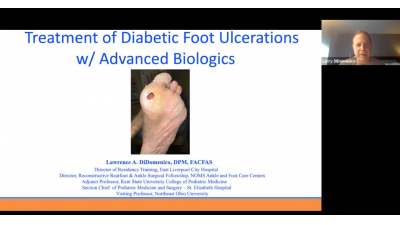
Practice Perfect 781
Podiatrists and Ankle Fractures
Podiatrists and Ankle Fractures

The most recent Journal of Foot and Ankle Surgery published an interesting research study about outcomes of ORIF of ankle fractures by podiatric surgeons. The study was positive toward podiatrists and elucidated a couple of important ideas to consider. Let’s review and analyze this study and see what it shows.
This was a retrospective cohort study by Weinraub and colleagues1 that covered an 8-year period in which podiatric surgeons in Kaiser Permanente Northern California repaired ankle fractures. They performed a text search to find ankle fractures treated surgically in their system, and documented patient demographic information, examining rates of complications including DVT, malunion, unplanned return to surgery, and postoperative infections. They found these complications by searching ICD 9 and 10 codes and manually reviewing the charts. They then compared these outcomes with national averages and performed a statistical analysis.
The final cohort under examination included 4610 ankle ORIFs performed on 4589 patients. Their complications are shown in the table below.
| Complication | Percent | N | Reported National Average from Orthopedic Literature (%) |
| DVT | 0.28 | 13 | 2.41 |
| Malunion/Nonunion/ Delayed union | 0.33 | 15 | 4.26 |
| Unplanned return to OR | 1.06 | 49 | 7.97 |
| Surgical site infection | 1.21 | 56 | 4.37 |
| 30-day readmission | 0.13 | 6 | Unknown |
The authors concluded that these improved outcomes compared with the national average show experience rather than professional degree is the important factor. I agree wholeheartedly with this conclusion. These podiatrists fix a lot of broken ankles! From personal experience working with a group of Kaiser podiatrists as part of our residency program and seeing their results firsthand (we do ongoing case discussions as part of our residency education, and ankle fractures come up frequently), I can attest they are highly experienced and skilled surgeons. I also give this group of surgeons kudos for publishing their results (although who would be afraid to publish these excellent outcomes?).
With that said, there are a few friendly criticisms we can make of this paper. The authors rightly state this is a retrospective cohort (rather than a prospective) study. However, I think this is actually a strength. If this were a prospective study, it is possible that knowing they would be part of a study could affect the outcome of that study. Instead, when these docs did their 4610 surgeries, they weren’t necessarily thinking the results would be published, which feels more authentic to real life.
My slightly larger concern is the control or comparison they used. Instead of using a direct comparison group such as orthopedists from Kaiser who also repaired ankle fractures, or perhaps a national database, they used the results of 3 orthopedic papers.3,4,5 It may have been prohibitively difficult, though, to find a direct comparison group. I doubt we will ever find a group of orthopedists doing ankle fractures of this volume and willing to compare their results. The problem with these studies is their low quality. One is a general review article from Foot and Ankle Clinics, not a research study2, two of the studies have low patient cohorts (one with 50 patients that were all aged 65 or greater and the other with 378 patients)3,4 and then the Chan article5, discussed below. Normally, I wouldn’t pick on using the 2 studies with low numbers (they do add up to 428 patients, not a bad number). However, the primary criticism of the Chan study that compared ankle ORIF outcomes between orthopedists and podiatrists was the unbalanced surgical numbers, heavily favoring podiatrists. We have to be careful not to fall into that same hole.
Since a direct comparison between Kaiser podiatrists and orthopedists is likely impossible, I would have liked to see Weinraub and colleagues instead compare the orthopedic outcomes of the Chan study (11,115 patients) to their own 4610 patients. It’s still lopsided, but much more representative of a very high volume of care. It would also have been a good rebuttal to that study, saying essentially, “pick on someone your own size,” by having a more reasonable comparison. I’ll bet good money that podiatrists would look a lot better than they did in Chan’s study. If we then take this comparison at face value, it’s fair to say these results are internally valid. Whether we can generalize these results to all podiatrists (external validity) is more difficult to say.
A more socially related criticism is in regard to the discussion section where the authors defend podiatrists. I would describe this as a well-intentioned response to the aforementioned Chan article5 that derided podiatrists as being inferior to orthopedists, explained by weaker education and training on the part of podiatrists (total nonsense based on flawed methodology). Although I entirely agree with every comment made by Weinraub, et al in the discussion, I would rather have them take the high road and let this good study and their excellent outcomes speak for themselves. Explaining podiatric training and citing two surveys showing that orthopedic trainees lack exposure to foot and ankle pathology during their training came across as too much of a direct response to the Chan article. On the other hand, the Chan article was a hit piece against podiatry, so maybe I’m not giving our intrepid authors enough credit for going head-to-head with orthopedics.
At the end of the day, Weinraub et al demonstrated pretty clearly – even with the small methodological challenges – that experience rather than specialty is an important determining factor for improved outcomes in ankle fracture open reduction internal fixation surgery.

-
Weinraub GM, Newport I, Kim BK, Zhu S, Patel S. Outcomes Following Open Reduction Internal Fixation of Ankle Fractures (ORIF) By Podiatric Surgeons. J Foot Ankle Surg. Epub 2021 Apr 11.
Follow this link -
Leyes M, Torres R, Guillén P. Complications of open reduction and internal fixation of ankle fractures. Foot Ankle Clin. 2003 Mar;8(1):131-147.
Follow this link -
Nilsson G, Jonsson K, Ekdahl C, Eneroth M. Outcome and quality of life after surgically treated ankle fractures in patients 65 years or older. BMC Musculoskelet Disord. 2007 Dec 20;8:127.
Follow this link -
Macera A, Carulli C, Sirleo L, Innocenti M. Postoperative complications and reoperation rates following open reduction and internal fixation of ankle fracture. Joints. 2018 May 21;6(2):110-115.
Follow this link -
Chan J, Truntzer J, Gardner M, Bishop J. Lower complication rate following ankle fracture fixation by orthopaedic surgeons versus podiatrists. J Am Acad Orthop Surg. 2019 Aug 15;27(16):607-612.
Follow this link

































Comments
There are 0 comments for this article